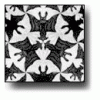Articles
Natural born mathematiciansNeuropsychologist Brian Butterworth tells us about research showing that even newborn babies have a basic understanding of number. It seems we are all mathematicians!
Mathematical mysteries: Strange GeometriesThe famous mathematician Euclid is credited with being the first person to axiomatise the geometry of the world we live in - that is, to describe the geometric rules which govern it. Based on these axioms, he proved theorems - some of the earliest uses of proof in the history of mathematics.
Maths in the dockChemists John Watling and Allen Thomas talk to Plus about the vital role of maths in presenting criminal evidence.
Mathematical mysteries: Survival of the nicest?One of the most puzzling aspects of human behaviour is cooperation, in situations where backstabbing and selfishness would seem to be more rewarding. From the point of view of evolutionary theory, the very existence of altruism and cooperation appear mysterious.
An infinite series of surprises
Infinite series occupy a central and important place in mathematics. C. J. Sangwin shows us how eighteenth-century mathematician Leonhard Euler solved one of the foremost infinite series problems of his day.
New designs from AfricaPaulus Gerdes takes us on a tour of the mathematical properties of some beautiful designs inspired by the traditional art of Angolan tribespeople.
Mathematical mysteries: Painting the PlaneSuppose you have an infinitely large sheet of paper (mathematicians refer to this hypothetical object as the plane). You also have a number of different colours - pots of paint, perhaps. Your aim is to colour every point on the plane using the colours available. That is, each point must be assigned one colour.
Backgammon, doubling the stakes, and Brownian motionBackgammon is said to be one of the oldest games in the world. In this article, Jochen Blath and Peter Mörters discuss one particularly interesting aspect of the game - the doubling cube. They show how a model using Brownian motion can help a player to decide when to double or accept a double.
Why knot: knots, molecules and stick numbersKnots crop up all over the place, from tying a shoelace to molecular structure, but they are also elegant mathematical objects. Colin Adams asks when is a molecule knot a molecule? and what happens if you try to build a knot out of sticks?
How big is the Milky Way?A question which has been vexing astronomers for a long time is whether the forces of attraction between stars and galaxies will eventually result in the universe collapsing back into a single point, or whether it will expand forever with the distances between stars and galaxies growing ever larger. Toby O'Neil describes how the mathematical theory of dimension gives us a way of
approaching the question.
RIP Claude ShannonClaude Shannon, who died on February 24, was the founder of Information Theory, which is the basis of modern telecommunications. Rachel Thomas looks at Shannon's life and works.
